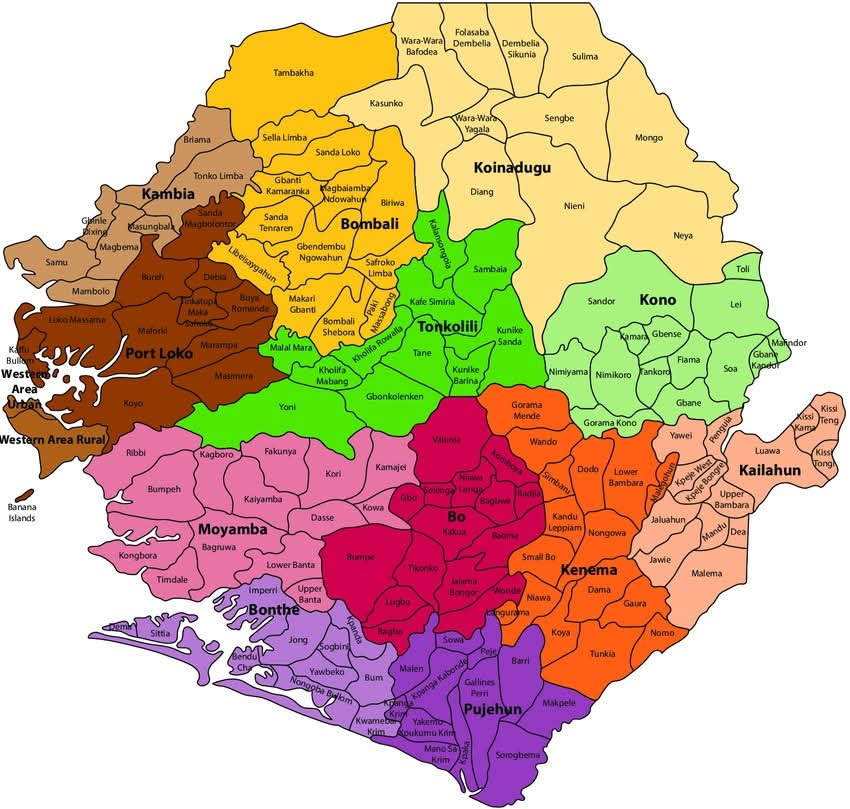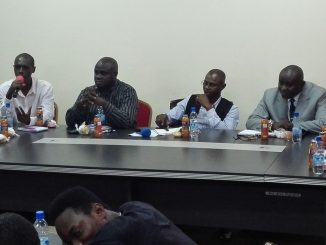
 THE CREATION OF NEW DISTRICTS IS USELESS AND UNCALLED FOR.
THE CREATION OF NEW DISTRICTS IS USELESS AND UNCALLED FOR.
By Mohamed Nyalley
The creation of additional districts in the present day Sierra Leone is one of the many endeavors that the government should not embark on at this point of devastated economical situation the country is currently facing.
Sierra Leone initially have 12 districts, the then government created 2 districts making it 14 as it is now, so as a small country already having 14 districts of which I think it’s enough for us to focus on developing them instead of creating new ones. It appears to me in an instance where somebody has already given birth to 14 children struggling to provide their basic needs to sustain, but yet impregnating another women who in less than no time would give birth to another two children summing up to 16 which is an additional burden to the very father who insinuated their birth.
However, we are going through a lot already as a small country in which if there’s good governance we’ll not suffer as such. The point I’m making here is that, we should not create another district, instead let’s focus on developing the ones we have already.
The country had overtime suffered from bad governance from both the traditional ruling and the main opposition parties that has led us since independence from failing to provide the citizenry with the basics as supposed i.e food, water, electricity, good road and education; for education is even worse than some of the other problems, it should be “education for all” (inclusiveness) but few days ago a 45 year old woman was discriminated openly just for trying to get educated and if I’m not mistaking it was this very government that blindfolded the people into believing that they enrolled a 60 year old father at the Bo school back in 2018 making it an inclusive right to education without discrimination.
Notwithstanding, the creation of additional districts in every unaccountable and devastated economy comes with so much implications.
1. INCREASE IN ADMINISTRATIVE COSTS.
More districts mean more spending on salaries, offices, vehicles, logistics, etc.
ECONOMIC IMPLICATIONS.
It diverts funds from essential services like healthcare, education, and infrastructure. Example: Nigeria has 700 local government areas and 36 states many of them struggle financially and rely on the federal allocations.
2. DUPLICATION OF GOVERNMENT FUNCTIONS.
Similar services (education, health, agriculture offices) would be replicated.
ECONOMIC IMPLICATIONS.
It leads to inefficiency and waste of resource leading to scarcity in public resources. Example; Kenya after devolution in 2010 created 47 counties making it difficult to bring service to the people leading to duplication of roles and wage on the government because without strong accountability there’ll be waste of resource.
3. BURDEN ON NATIONAL BUDGET.
Sierra Leone already faces fiscal challenges and high debt, there’s already lack of trust from the puppet masters of which creation of new districts means a lot.
ECONOMIC IMPLICATIONS.
Expanding administrative structures adds pressure on the budget and may increase borrowing. For instance; South Sudan increase states from 10 to 32 in 2015, then reversed it in 2020 due to conflict and budget strain.
4. POTENTIAL FOR POLITICAL TENSIONS.
Creating new districts could trigger regional or ethnic disputes over boundaries or capital towns.
ECONOMIC IMPLICATIONS.
Social instability can deter investment and disrupt local economies. Ghana’s Region Creation Conflicts (2018)
Proposals to create new regions led to disputes over boundary delineations, especially in areas like Hohoe and Nkwanta. Tensions escalated into violent clashes between youth groups, reflecting deeper ethno-political divisions and concerns over traditional authority and resource allocation. Yugoslavia’s Administrative Reorganization (1929–1934), is another instance. King Alexander’s attempt to reorganize Yugoslavia into new administrative divisions disregarded ethnic boundaries, aiming to suppress nationalism.
5. LIMITED ECONOMIC JUSTIFICATION.
Many current districts lack basic infrastructure and revenue generation capacity. What’s the economic value of the said proposed districts? Creating an additional local government areas or district comes with a lot of economic challenges.
ECONOMIC IMPLICATIONS.
New districts might remain dependent on central government funding without contributing to the GDP growth of a country. Nigeria is an example, of all their excellent economic impact for scores of year now in Africa yet they still challenges with regards the basics of life, electricity is not to be included. As of 2025, the average Nigerian citizen faces significant economic challenges, with the country’s GDP per capita declining to approximately 835, marking a substantial decrease from around 3,220 in 2014. This decline reflects a reduction of over 70% in average income over the past decade, indicating that economic growth has not kept pace with population increases and that inflation has eroded purchasing power. Inflation rates have soared, reaching nearly 34.8% by December 2024, significantly diminishing the real value of incomes and making basic goods and services less affordable. The Nigerian naira has experienced substantial devaluation, with exchange rates reaching ₦1,500 per USD, leading to increased costs for imported goods and further straining household budgets. Over 50% of Nigeria’s population, approximately 129 million people, are struggling to meet basic needs, highlighting the widespread impact of economic hardships. When compared to neighboring countries, Nigeria’s GDP per capita is notably lower: with Ghana approximately 2,189, Kenya approximately 2,186.
Comparatively as of early 2025, Sierra Leone’s inflation rate has shown a high rate, indicating no room for improvements in the country’s economic stability. According to the latest data from sources, the annual inflation rate stood at 34.03% in January 2025 a drastic increase from 24.78% in December 2024. This marks a substantial increase from the peak of 14.59% in October 2023, reflecting the recklessness of the recent fiscal and monetary policies in causing high inflation in the country. Neighbouring Guinea is by far improve than us over the past three years in terms economic growth, as of early 2025, Guinea’s inflation rate has shown a notable decline. In December 2024, Guinea’s annual inflation rate decreased to 3.09%, down from 4.93% in November 2024. This marks a significant reduction from the average inflation rate of 7.8% in 2023, making Guinea’s three times better and economically stable than Sierra Leone.
However, there are several factors that have contributed to the high inflation in Sierra Leone:
•Reckless spending of government officials from the consolidated fund.
•poor agricultural output. The country is currently doing so bad with export and even production leading to a high level of starvation thereby turning the citizens into hungry fellows.
•Unstabilize exchange rate. The rapid exchange devastated condition i.e dollar from $1 equivalent to le10 in 2021 is now $1 equivalent to le24 has caused some damage on the country’s economy and if no measure is taken to control that, there’s a likelihood of an exorbitant increase of $1 equivalency to le28 by December 2025.
So for me it’s not about politics but the GREEN, WHITE & BLUE🇸🇱 and it’s really of immense importance for us to start thinking Sierra Leone and developing our beloved nation than acting politically without any vision for growth and that vision is either now or never.
#landthatwelove




Leave a Reply